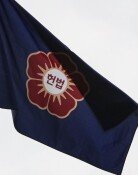U.S. and Arab allies launch airstrikes in IS strongholds in Syria
U.S. and Arab allies launch airstrikes in IS strongholds in Syria
Posted September. 24, 2014 04:26,
Several Tomahawk Land Attack Missiles were launched from the Red Sea-based USS Arleigh Burke at 4:30 a.m. on Tuesday, right before the sun rose over the horizon of Syria off the Mediterranean coast. The U.S. Central Command launched airstrikes from the USS Cole, a destroyer currently in the Mediterranean, targeting Syria with Tomahawk cruise missiles.
A few minutes later, red lights began to emerge in the sky of Syria`s northern city of Raqqa, the Islamic State`s de facto capital. It was the moment when the U.S. and Arab allies launched airstrikes against in the stronghold of the Islamic Sunni militants or the IS.
The aircraft carrier USS George H.W. Bush (CVN-77), which transited in the Gulf off the southeast of Iraq, launched F16 and F18 strike fighters, Air Force B-1 bombers and unmanned aircraft. The airstrikes were reinforced by US Air Force bombers and fighters from air force bases in neighboring Arab countries. F-22 stealth Raptors fighter jets were also used for the first time, while the Predator unmanned aircraft joined the airstrikes.
The first airstrikes of the U.S. and allies lasted for about 90 minutes and aimed at some 20 targets near Raqqa. In addition, three other regions in Syria were affected. The airstrikes destroyed most military facilities of the Islamic State, including the headquarters and the command and control facilities, break camps, weapon stores, fuel depots, and training compounds. CNN reported that the U.S.-led airstrikes killed several IS militants. The U.S. forces continued several more airstrikes on the day.
The airstrikes were conducted not only by the U.S. but also jointly by five Arab nations -- Saudi Arabia, Jordan, the United Arab Emirates, Bahrain, and Qatar. U.S. Air Force fighter and bombing jets took off from Al Dhafra Air Base in the United Arab Emirates, Shaikh Isa Air Base in Bahrain, and Al Udeid Air Base in Qatar. These countries offered their air force bases and allowed U.S. fighters and bombers to use their airspace.
President Obamas earlier than expected airstrikes in Syria seem to have considered the opinion that a delay in airstrikes, which he vowed in his Sept. 10 speech, could give the IS militants more time for escape. His political intention was also behind the decision that could offset the criticism that the president has been too weak in major global issues in the run-up to the November mid-term election.
On the decision of the airstrikes at the beginning of the week when the U.N. General Assembly is held, a diplomatic source from Washington said that it would be an opportunity for President Obama who has argued for an operation not by the U.S. alone but by global allies to appeal the international community to join defeating the IS.
The airstrikes are likely to change the U.S. Middle East policy. Some are concerned about the U.S. being trapped in the Middle East again as the Obama administration, which has gradually pulled out of war in Afghanistan and Iraq, practically makes a U-turn intervening in Iraq and Syria.
Headline News
- Med professors announce intention to leave hospitals starting Thursday
- Bridge honoring Sgt. Moon Jae-sik unveiled in Pennsylvania
- Chief of Staff Chung tells presidential secretaries to stay away from politics
- US FTC bans noncompete agreements
- N. Korea launches cyberattacks on S. Korea's defense companies







